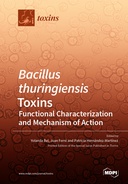Explore

<em>Bacillus thuringiensis</em> Toxins: Functional Characterization and Mechanism of Action
0 Ungluers have
Faved this Work
Login to Fave
Bacillus thuringiensis (Bt)-based products are the most successful microbial insecticides to date. This entomopathogenic bacterium produces different kinds of proteins whose specific toxicity has been shown against a wide range of insect orders, nematodes, mites, protozoa, and human cancer cells. Some of these proteins are accumulated in parasporal crystals during the sporulation phase (Cry and Cyt proteins), whereas other proteins are secreted in the vegetative phase of growth (Vip and Sip toxins). Currently, insecticidal proteins belonging to different groups (Cry and Vip3 proteins) are widely used to control insect pests and vectors both in formulated sprays and in transgenic crops (the so-called Bt crops). Despite the extensive use of these proteins in insect pest control, especially Cry and Vip3, their mode of action is not completely understood. The aim of this Special Issue was to gather information that could summarize (in the form of review papers) or expand (research papers) the knowledge of the structure and function of Bt proteins, as well as shed light on their mode of action, especially regarding the insect receptors. This subject has generated great interest, and this interest has been materialized into the 18 papers of important scientific value in the field (5 reviews and 13 research papers) that have been compiled in this issue.
This book is included in DOAB.
Why read this book? Have your say.
You must be logged in to comment.
